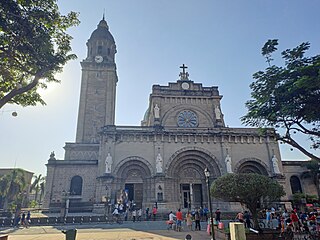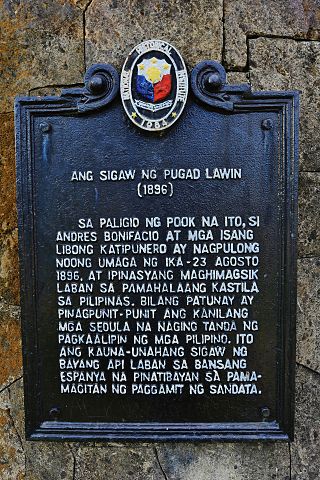Related Research Articles
The military history of the Philippines is characterized by wars between Philippine kingdoms and its neighbors in the precolonial era and then a period of struggle against colonial powers such as Spain and the United States, occupation by the Empire of Japan during World War II and participation in Asian conflicts post-World War II such as the Korean War and the Vietnam War. The Philippines has also battled a communist insurgency and a secessionist movement by Muslims in the southern portion of the country.

Ilocos Sur, officially the Province of Ilocos Sur, is a province in the Philippines located in the Ilocos Region in Luzon. Located on the mouth of the Mestizo River is the capital of Vigan. Ilocos Sur is bordered by Ilocos Norte and Abra to the north, Mountain Province to the east, La Union and Benguet to the south and the South China Sea to the west.

Diego Silang y Andaya was a Filipino revolutionary leader who allied with British forces to overthrow Spanish rule in the northern Philippines and establish an independent Ilocano state. His revolt was fueled by grievances stemming from Spanish taxation and abuses, and by his belief in self-government, that the administration and leadership of the Roman Catholic Church and government in the Ilocos be invested in trained Ilocano officials. His wife, the Itneg Gabriela Cariño, took on leadership of his revolt after his assassination.

Sulayman, sometimes referred to as Sulayman III, was a Crown Prince of the Kingdom of Luzon in the 16th century and was a nephew of King Ache of Luzon. He was the commander of Luzonian forces in the battle of Manila of 1570 against Spanish forces.

The 1896 Philippine Revolution was a conflict waged by the Filipino revolutionaries against the Spanish colonial authorities in an attempt to win the archipelago's independence. It began on August 24, 1896, when the Spanish authorities discovered the Katipunan, an anticolonial secret organization.

The Catholic Church in the Philippines or the Filipino Catholic Church is part of the worldwide Catholic Church, under the spiritual direction of the Pope and the Catholic Bishops' Conference of the Philippines (CBCP). The Philippines is one of the two nations in Asia having a substantial portion of the population professing the Catholic faith, along with East Timor, and has the third largest Catholic population in the world after Brazil and Mexico. The episcopal conference responsible in governing the faith is the Catholic Bishops' Conference of the Philippines.

Gómez Pérez Dasmariñas was a Spanish politician, diplomat, military officer and imperial official. He was the seventh governor-general of the Philippines from May or June 1, 1590 to October 25, 1593. Dasmariñas was a member of the Order of Santiago.

During the Spanish colonial period in the Philippines (1565–1898), there were several revolts against the Spanish colonial government by indigenous Moro, Lumad, Indios, Chinese (Sangleys), and Insulares, often with the goal of re-establishing the rights and powers that had traditionally belonged to Lumad communities, Maginoo rajah, and Moro datus. Some revolts stemmed from land problems and this was largely the cause of the insurrections that transpired in the agricultural provinces of Batangas, Bulacan, Cavite, and Laguna. Natives also rebelled over unjust taxation and forced labor.

Luis Pérez Dasmariñas y Páez de Sotomayor was a Spanish soldier and governor of the Philippines from December 3, 1593 to July 14, 1596. In 1596, he sent unsuccessful expeditions to conquer Cambodia and Mindanao.

Francisco de Tello de Guzmán was Spanish governor of the Philippines from July 14, 1596 to May 1602. He was a knight of the Order of Santiago.

Pedro Bravo de Acuña was a Spanish military officer and colonial official in the New World and the Philippines. From 1602 to 1606 he was the eleventh governor of the Philippines.

Jacinto Zamora y del Rosario was a Filipino Catholic priest, part of the Gomburza, a trio of priests who were falsely accused of mutiny by the Spanish colonial authorities in the Philippines in the 19th century.
The Tondo Conspiracy of 1587, popularly known as the Conspiracy of the Maginoos, also known as the Revolt of the Lakans, was a revolt planned by Tagalog nobles known as maginoos, led by Don Agustin de Legazpi of Tondo and his cousin Martin Pangan, to overthrow the Spanish government in the Philippines due to injustices against the Filipinos. It was territorially one of the largest conspiracies against the Spanish rule next to the Katipunan. It ranged from provinces near Manila all the way to the Calamianes Islands near Palawan.

The Cry of Pugad Lawin was the beginning of the Philippine Revolution against the Spanish Empire.

The history of the Philippines from 1565 to 1898 is known as Spanish colonial period, during which the Philippine Islands were ruled as the Captaincy General of the Philippines within the Spanish East Indies, initially under the Viceroyalty of New Spain, based in Mexico City, until the independence of the Mexican Empire from Spain in 1821. This resulted in direct Spanish control during a period of governmental instability there. The Philippines was under direct royal governance from 1821 to 1898.
The Bankaw revolt (1621–1622) was a religious uprising against Spanish colonial rule led by Bankaw or Bancao, datu of Limasawa, Carigara, Abuyog, Sogod. He warmly accepted Miguel Lopez de Legazpi when he arrived in the Philippines in 1564, and was converted as a Christian. Being hospitable toward de Legazpi and his men, he received a letter of gratitude from the Spanish King, Philip II. He also received a gift from the king in recognition of his grandfather's hospitality to Ferdinand Magellan. Though he was one of the first converts of Catholicism under de Legazpi, he left his faith and allegiance to the Spanish after around fifty years. Together with a babaylan named Pagali and his children, he built a temple for a diwata, and he incited people from six towns to participate in the revolt. It is believed that Pagali used some magic to attract followers, and thought that they could turn the Spaniards into clay by hurling bits of earth at them.

The Battle of Imus, or the siege of Imus, was the first major battle of the Philippine revolution against the Spanish colonial government in the province of Cavite. It was fought between September 1–3, 1896 at Imus, Cavite province in the Philippines, right after Bonifacio's attack on the gunpowder magazine at the Battle of San Juan del Monte in Manila.

The 1990 Mindanao revolt was an uprising that occurred in parts of the island of Mindanao in the southern Philippines. It began when Alexander Noble, a dissident Philippine Army colonel linked to the 1989 Philippine coup attempt against President Corazon Aquino, and his supporters seized two military garrisons in Cagayan de Oro and Butuan without firing a shot and unilaterally proclaimed the independence of the Federal Republic of Mindanao on October 4, 1990, to be led by a civilian-military junta and with an ultimate goal of removing Aquino from office. However, he failed to gain support, and surrendered two days later following attacks by government forces. The revolt was the last overt attempt to overthrow Aquino's government until the end of her term in 1992.

The Battle of Sambat was the culminating battle of the first revolts of the Katipunan in Laguna. The battle was the final major action for the Katipunan chapter of "Maluningning" ending in the defeat of the rebels and martial law in Laguna province.
The Spanish–Chamorro Wars, also known as the Chamorro Wars and the Spanish–Chamorro War, refer to the late seventeenth century unrest among the Chamorros of the Mariana Islands in the western Pacific Ocean against the colonial effort of Habsburg Spain. Anger at proselytizing by the first permanent mission to Guam, which was led by Diego Luis de San Vitores, and a series of cultural misunderstandings led to increasing unrest on Guam and a Chamorro siege of the Hagåtña presidio incited by maga'låhi (Chief) Hurao in 1670. Maga'låhi Matå'pang killed San Vitores in 1672, resulting in a campaign of Spanish reprisal burnings of villages through 1676. Local anger at the attacks against villages resulted in another open rebellion led by Agualin and a second siege of Hagåtña. Governor Juan Antonio de Salas conducted a counter-insurgency campaign that successfully created a system of collaboration in which Guamanians turned in rebels and murderers and transferred most of the people from about 180 villages to seven towns, a policy known as reducción. By the early 1680s, Guam was largely "reduced," or pacified.
References
- ↑ Bartleby, The Philippines 1500-1800, archived from the original on 2008-06-26, retrieved 2008-07-04